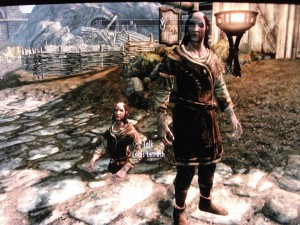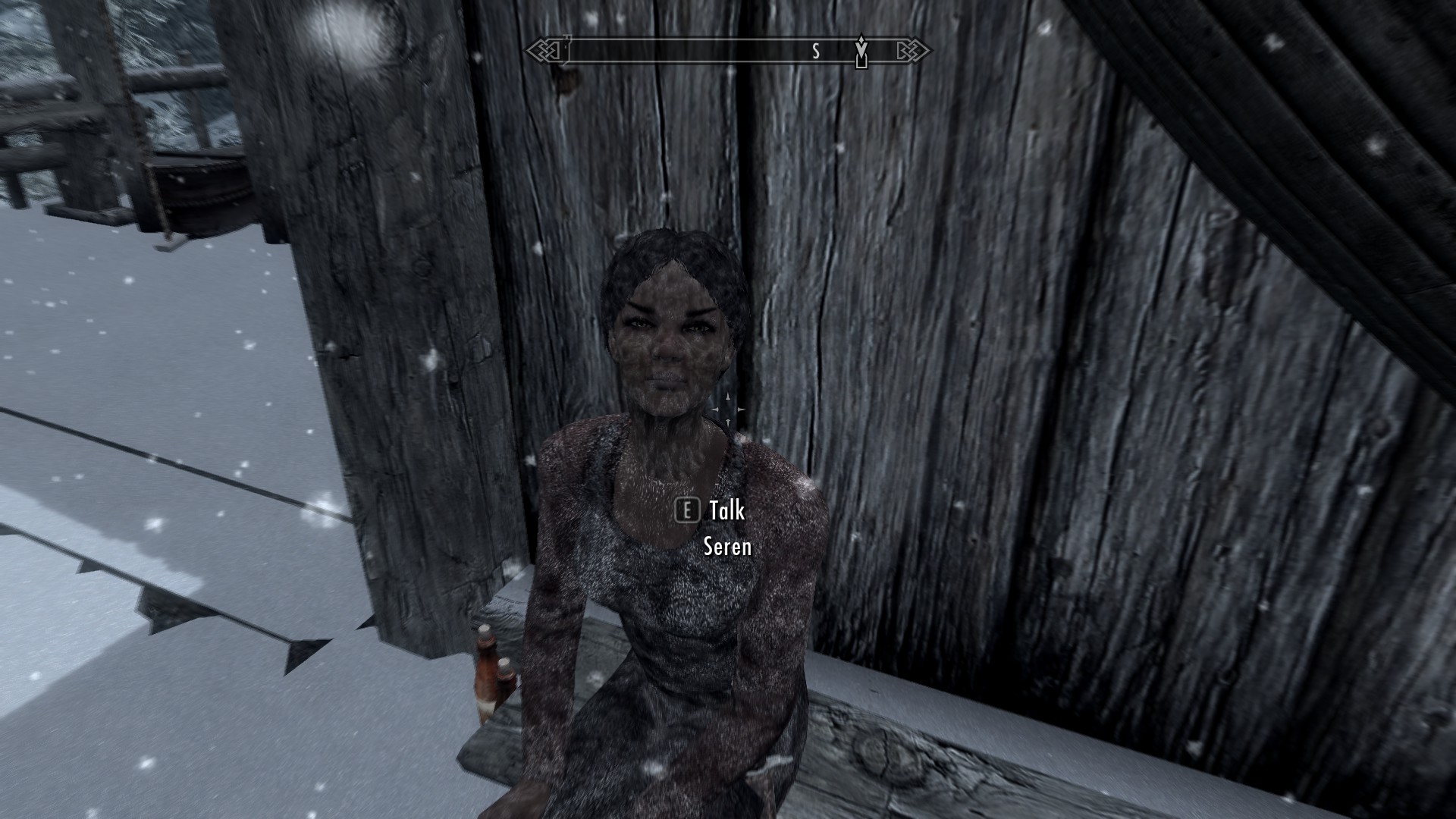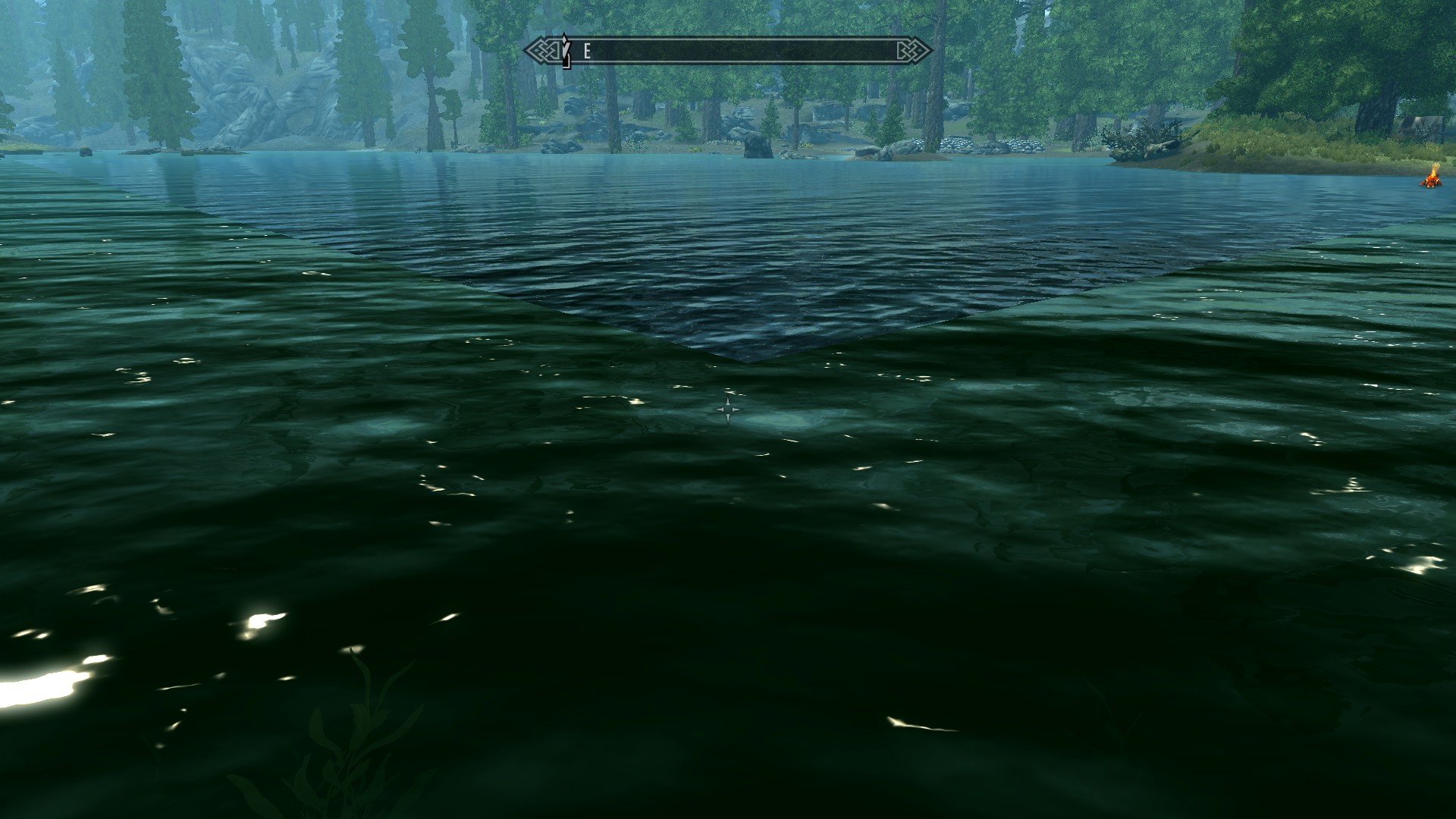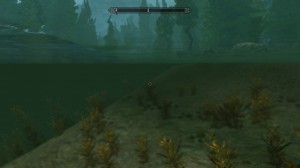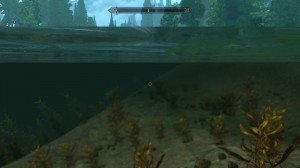The post The Poetry of Patch Notes appeared first on &.
]]>In one of her later essays, Eve Sedgwick (2012) muses ‘sometimes I think the books that affect us most are… the books we know about – from their titles, from reading reviews, or hearing people talk about them – but haven’t, over a period of time, actually read’ (123). Unread, these books can remain ‘objects of speculation, of accumulated reverie’ (ibid.), proving enduringly provocative or inspirational even if what we extrapolate from them is wrong. Sedgwick’s observation, of course, does not apply solely to books – one might, for example, imagine ‘It’s All Over Now, Baby Blue’ to be addressed to a person who’s just overcome some kind of dire tribulation, rather than someone with no options left; Sedgwick herself made hay with the fact that her essay ‘Jane Austen and the Masturbating Girl’ was held up as an exemplar of all that was wrong with literary study not just before its critics had read it but before it had even been written (1994, 15).
As for books, films, songs and essays, so for games: video game titles can be both evocative and deceptive, all the more so because even when we know what a game looks like it is hard to determine how it will feel until the controller is in our hands. Personally, I have always been highly susceptible to the allure of Japanese games with so-called “Engrish” titles – Bulk Slash; Virtual On: Oratorio Tangram; Omega Boost. As Trevor Harrison (2008) argues, “Engrish” is characterized by constructions that might seem bizarre or just comically wrong to the native English speaker, but which are, in many cases, governed by an ‘internal logic’ based on creating unaccustomed and even outright paradoxical syntactical combinations productive of a certain connotative frisson (144-6). Prioritizing feeling, novelty and impact over straightforward sense, this strategy is a good fit for the kinds of visceral spectacle in which the games named above trade.
It is not just games’ titles that speak to us, for this is an industry in which developers and publishers often have recourse to buzz terms, bullet points and neologisms in order to convey how their product works and just what distinguishes it from its rivals. From Shenmue’s ‘quick time events’ to Red Faction‘s ‘Geomod technology’ to Forza 5’s ‘drivatars’ and Battlefield 4’s ‘levolution’ system, video games are in love with unwieldy coinages. A staple of back-of-the-box feature lists, such terms are easily ridiculed, but we might productively see them as constituting an understudied microgenre of game-writing – commercially motivated to be sure, but also a key means of ‘paratextual’ mediation between developer and potential player (Genette, 1997).
Try as they might to entice us, however, such terms ultimately tend to be too vague, not to mention too empty, to truly tantalize. Fortunately there is another kind of gamic paratext that, while tailored to a different (in fact, an almost almost diametrically opposite) purpose, often proves more adept at piquing playerly curiosity: patch notes. Insofar as they list the problems that a particular software update will attempt to fix, cataloguing flaws, conflicts and oversights, these texts should provide a sobering counterpoint to the heady claims made by feature lists. In practice, however ironically, they often afford us intriguing insights into the nature of a game’s operation and appeal.
Skyrim (which title, we might note in passing, wags have suggested better befits a toilet cleaner than a fantasy role-playing game) provides a helpful case in point. The game was released on the eleventh of November 2011 in what was, even for the famously bug-prone Bethesda Softworks, a formidably glitchy state: dragons flew backwards; corpses arbitrarily dematerialized; monsters’ skeletons became lodged in solid walls. By the end of the month the game had been patched to version 1.2, and the patch notes that accompanied this update have since come to be regarded as something of a classic of the genre, exemplifying the power of such texts to synecdochically gesture at the complexities, the forms of emergent spectacle, the proliferating possibilities that made the game so engaging in the first place. Moreover, as Kenneth Goldsmith (2011) would no doubt point out, you only have to remove one line to make the list into an albeit rather unconventional sonnet:
UPDATE 1.2 NOTES (all platforms unless specified)
Improved occasional performance issues resulting from long term play (PlayStation 3)
Fixed issue where textures would not properly upgrade when installed to drive (Xbox 360)
Fixed crash on startup when audio is set to sample rate other than 44100Hz (PC)
Fixed issue where projectiles did not properly fade away
Fixed occasional issue where a guest would arrive to the player’s wedding dead
Dragon corpses now clean up properly
Fixed rare issue where dragons would not attack
Fixed rare NPC sleeping animation bug
Fixed rare issue with dead corpses being cleared up prematurely
Skeleton Key will now work properly if player has no lockpicks in their inventory
Fixed rare issue with renaming enchanted weapons and armor
Fixed rare issue with dragons not properly giving souls after death
ESC button can now be used to exit menus (PC)
Fixed occasional mouse sensitivity issues (PC)
General functionality fixes related to remapping buttons and controls (PC)
Most commentators immediately seized upon the line about dead wedding guests, a teasingly terse clause that might have been custom-engineered to elicit awe, amusement and curiosity. While I had already sunk a good number of hours into the game by the time this text was disseminated, I was not, prior to reading these notes, even aware that it was possible to get married in Skyrim, and was still less able to imagine how the scenario of a corpse arriving at my avatar’s wedding would actually play out (would they be upright? Would there still be flesh on their bones? What differentiated a dead Nord from a living one?). If Bethesda had done an admirable job of hyping the game prior to release (harping particularly on the importance of the ‘radiant storytelling’ system that would generate a literally endless supply of quests) the scenario sketched in this one line arguably gives a much clearer sense of what makes Skyrim special than any developer interview or press release could – indeed, one wonders just how many players, upon reading the notes, purposefully avoided downloading the update in favour of booting up the game and going a-wooing.
I should perhaps make it clear at this point that by drawing attention to patch notes I am not attempting to prop up the by now rather tired argument that glitches have the potential to somehow cut through gaming’s illusionistic patina, putting us in touch with something more ‘real’. Instead, I want to suggest that in the patch note we might find inklings of a mode of writing capable of doing justice to gaming’s virtual dimension (in the properly probabilistic sense), of capturing the way in which players can simultaneously (or almost simultaneously) experience games as captivating fictions, technical achievements and bug-ridden pains in the neck. The rest of the list, while devoid of any single item quite so compelling as the dead guest clause, is interesting and instructive in other respects, and does much to suggest the multifaceted nature of both games and gameplay. Particularly noteworthy are its tellingly coy circumlocutions (PS3 performance issues are not fixed but ‘improved’; Bethesda would struggle to get this version of the game stable over an extended series of updates spanning several months) and its bracingly abrupt switches in register, from metaphysical considerations in one line to banal technical minutiae the next (“Fixed rare issue with dragons not properly giving souls after death /ESC button can now be used to exit menus (PC)”). In this last respect the document resonates with Ian Bogost’s (2012) comments on the list as an ‘ontographic’ technology, a mode whereby a ‘particular configuration [may be] celebrated simply on the basis of its existence’ (38). For Bogost, lists, which are functional first and foremost, offer a salutary corrective to more ‘literary’ modes of description, enjoining attention to specific details, to the fact that ‘no matter how fluidly a system may operate’ it will depend to some degree on the (often uneasy) collaboration of elements that remain, on a fundamental level, ‘utterly isolated [from one another], mutual aliens’ (ibid. 40). In Skyrim’s case we can see how the interoperation of different features and protocols within the game system supported an experience that some found captivating, others ‘broken’ and far from fluid.
As we might imagine, what is true of professional commercial products is also true of mods, with the important difference that the barrier to entry is lower than with full retail games: with no need to pay, owners of the original game have little reason not to download an add-on and see for themselves whether it lives up to the claims made in its maker’s blurb. Skyrim has a particularly active mod scene, one in which the cut-throat competition for downloads and upvotes has bred a discourse rife with inflated promises, unwieldy acronyms (W.A.T.E.R. = Water and Terrain Enhancement Redux), and much loose usage of the term immersive. Again, however, descriptions of bugs and glitches tend to paint a picture that is at once more reflective of the actual experience on offer and more capable of supporting speculation, fantasy and projection. It is not uncommon for modders to admit that they have no idea why users are experiencing particular problems, and such admissions – which are, in some cases, very detailed and frank – offer glimpses into the logical guts of the game that can be as dizzying as any polygonal vista. I leave you with some snatches from modder Araanlm’s notes on his Here There be Monsters mod, notes I find both cryptic and strangely romantic: “Somehow in doing this I managed to mess up the original location of Jormungandr, which was just north of Northwatch Keep. I moved him to a different island north of Orphan’s Tear, but the original location is still messed up and causes a crash to desktop… I’m not sure if the monsters can actually use [summoning spells] since they are not human NPCs.”
Araanlm (2013). Here There be Monsters. Steam Workshop. http://steamcommunity.com/sharedfiles/filedetails/?id=81166964
Betheda Blog (2011, November 30). Skyrim 1.2 Update. http://www.bethblog.com/2011/11/30/skyrim-1-2-update/
Bogost, Ian (2012). Alien Phenomenology, or, What its like to be a Thing. Minneapolis: University of Minnesota Press.
Genette, Gerard (1997). Paratexts: Thresholds of Interpretation. Cambridge: Cambridge University Press.
Goldsmith, Kenneth (2011). Uncreative Writing: Managing Language in the Digital Age. New York: Columbia University Press.
Harrison, Trevor (2008). 21st Century Japan: Anew Sun Rising. London: Black Rose Books.
Sedgwick, Eve Kosofsky (1994). Tendencies. Durham NC: Duke University Press
- (2012). The Weather in Proust. Durham, NC: Duke University Press.
The post The Poetry of Patch Notes appeared first on &.
]]>The post Disruptive Mods and Skyrim appeared first on &.
]]>As part of the IMMERSe research I’m currently involved in, our team has been spending time lately examining mods for the Bethesda Elder Scrolls game Skyrim. Mods are (generally) user generated content for commercially produced and distributed games, and can alter anything from the realism of how light reflects off of surfaces in the game to building whole new environments for players to explore and missions for players to complete. Our primary focus has been on immersive, narrative mods that significantly effect the story aspects of the game, but one particular point of interest I’ve developed over the last couple months has been when mods fail, or at least appear to fail in their intended, stated goal. In the interest of seeing what happens when mods break themselves, break each other, or break gameplay, I enlisted some colleagues and went about trying to see how we could use mods to fuck up Skyrim.
It wasn’t hard to screw up our Skyrim play. We used a very simple methodology–throw a whole bunch of mods on the game at once and see what happens. We installed and ran multiple aesthetic mods: dozens of patches designed to add richer textures, more realistic dust in the air, detailed sound effects, and so on. Also installed were large narrative mods like the Falskaar pack (which gives a player an additional 25 hours of playable missions and adds a new map to the game about a third of the size of Skyrim itself) and other interactive mods that alter the way the player interfaces with the environment. The hope in running all these mods at once is that one mod gets in the way of another in a really interesting way, and that the player consequently gets a chance to learn about how the game functions or see it from a new perspective (another hope might be that all these mods just overload the computer’s brain, but we were playing on a really powerful machine). As I said, this wasn’t hard to achieve. Turning on the Falskaar map and mission pack, we set about to try some new adventures, but some of the survival mods we’d installed got in the way of us going about our business. Survival mods effect your ability to deal with the elements, so swimming is a bad idea–your stamina will fall away, your vision will blur, and eventually bone chill will set in. Unfortunately, all the traditional ways to warm yourself up and dry yourself off have been disabled by some other mod, so you’re at a loss for what to do. We eventually found an indoor fire that built our player’s stamina, but by then we’d wasted about twenty minutes. Meanwhile, our cold weather mod was giving all of the Falskaar NPCs frostbite. We decided to head back to Skyrim proper before anyone died of exposure.
An effect of our Cold and Wet mod in Falskaar. This woman is not supposed to look like this.
One of the problems with using so many mods at once was that is was sometimes hard to tell which mods were glitching. One audio mod forces the player to turn her head in order to hear any dialogue (though effects, music, and ambient sounds are always audible). The strange algorithmic logic of such a mod–ears are on the side of the head and necessary for hearing, so obviously you want to point your ears toward the source of sound–are reminiscent of some of the AAA games of the last decade, where turning or walking away from the source of sound turned the volume on it way down. However, larger immersive Skyrim mods such as Falskaar also include dialogue recorded by amateur voice actors, often in their homes or some other locale lacking the benefit of soundproofing. The final result is that the player turns her head to hear dialogue from a barmaid who sounds like an American teenager doing a bad British accent with a dishwasher running in the background. These sounds aren’t so much non-diegetic as they are acousmatic–it’s impossible to tell just where the sounds are coming from, or if they’re meant to be in the world or not, a question raised by the fact that the player’s modded character is apparently hard of hearing when it comes to human voices.
Then there were the mods that changed the look of the environment. Now these were interesting. I had hoped that by running multiple mods designed to affect the same game elements, we might get to see a total breakdown of the game’s visual interface processes. We ran two water mods at the same time, and I hoped that when we approached a lake we would observe a pixelated flickering mess as the two mods fought for control over what the player saw. Instead, they just cooperated and cut the lake right in half. Sections of the water were green, others were blue, and the areas were separated by nice clean lines and right angles. Even underwater a flick to the right would change the opaqueness and tinting of the view, while up above an invisible boundary marked the difference between ebb and flow and the waters rippled in opposite directions. Meanwhile, multiple tree mods had an easy time getting along too–some would exist in the same space (making for interesting topiary arrangements), while others were sometimes pushed up out of the ground–not to fall over, but rather to float overhead, suspended in the air.
Two waters mods getting along swimmingly, while my flaming horse (also a mod) paddles through with undampened spirits.
Water mods just a bit to the left or right.
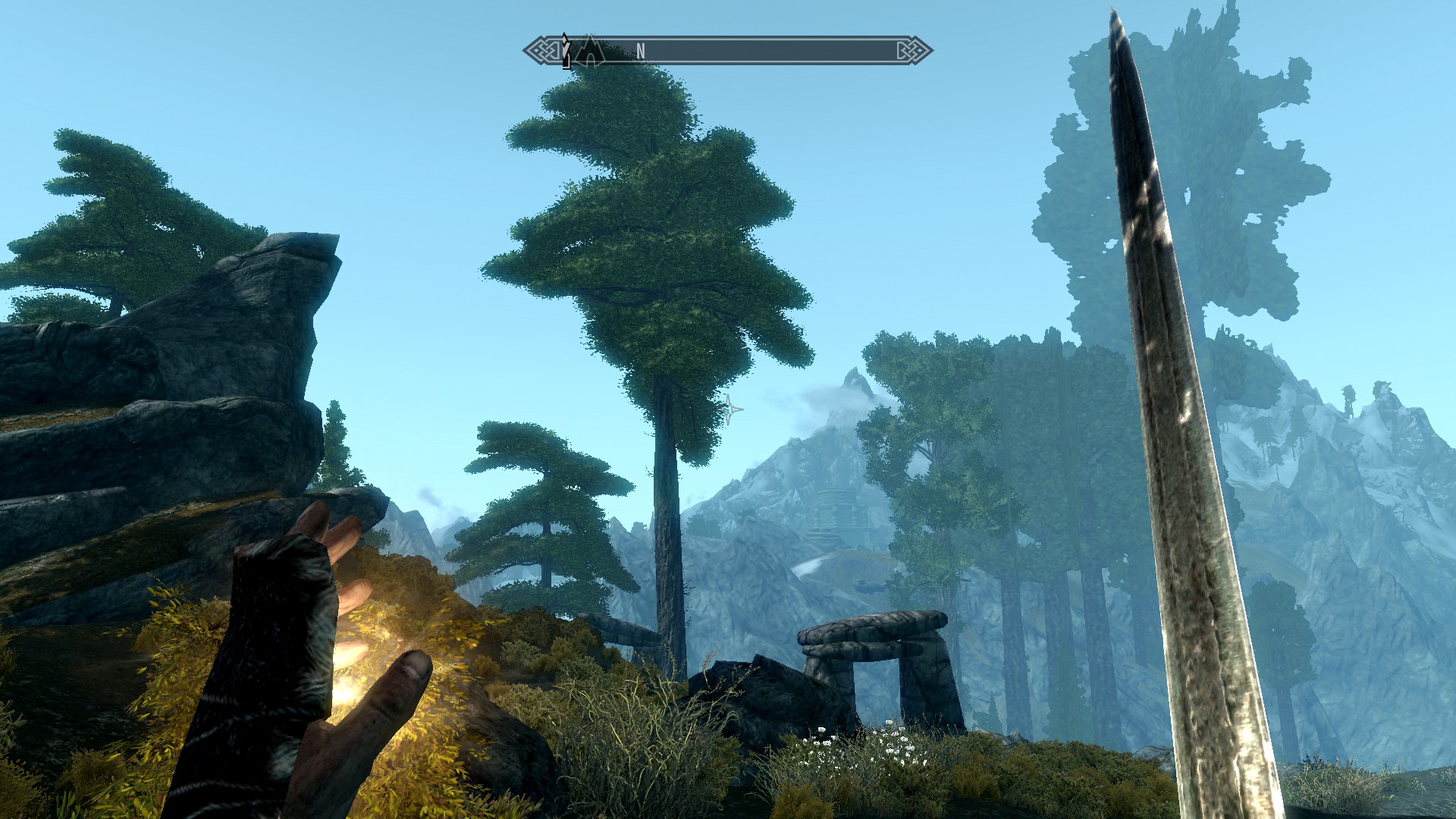 While some multiply-modded trees glitched out visually…
While some multiply-modded trees glitched out visually…
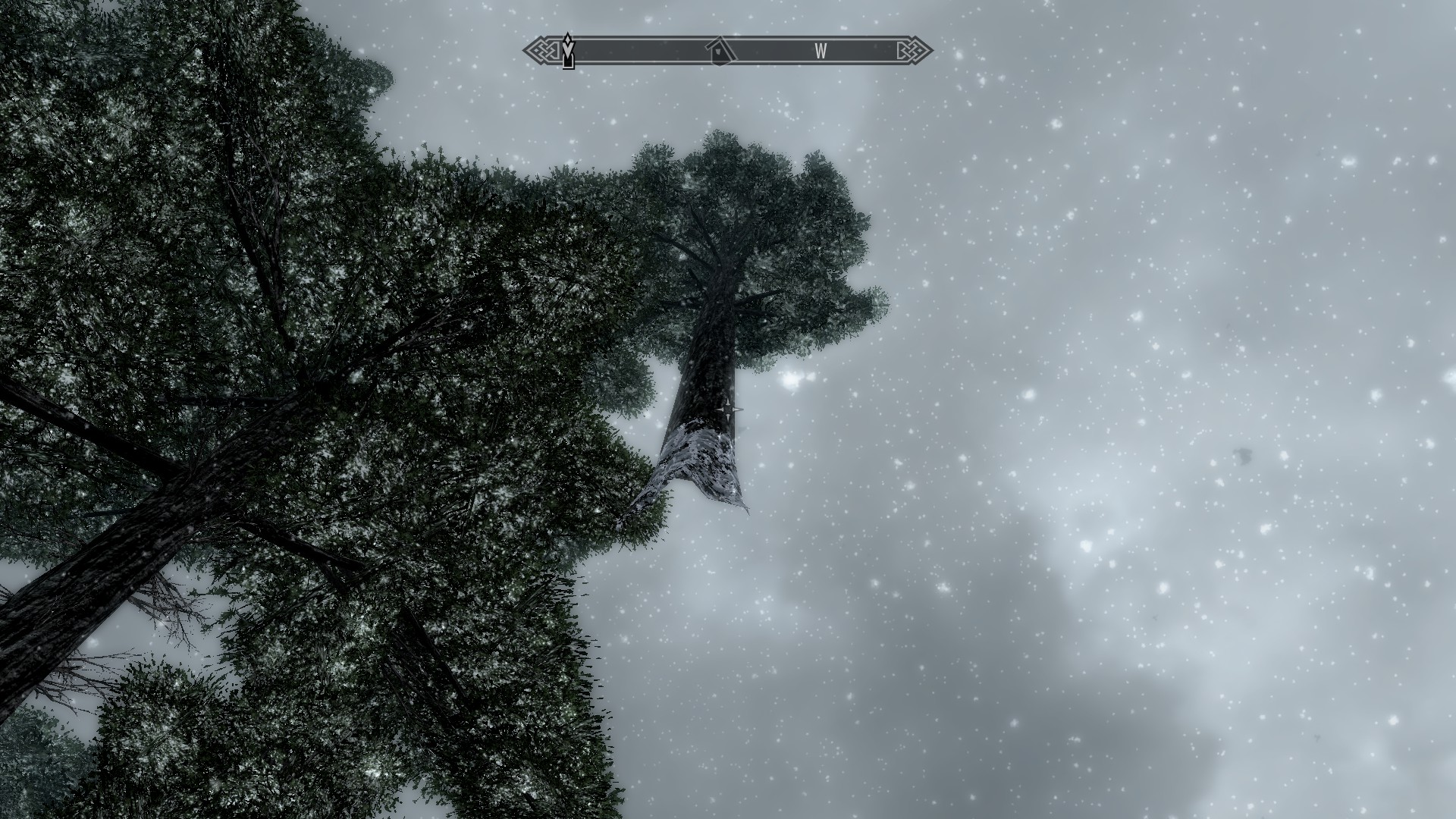 …others were altered spacially.
…others were altered spacially.
These kinds of mod glitches shed new light on the software processes of the game. Rather than seizing up or prioritizing one mod over the other, the system has opted to resolve the conflict in what it thinks of as an equitable fashion. While we generally think of a game as incapable of breaking its own rules, Skyrim here has dealt with an informational surplus by simply incorporating all options. At least, that’s how it works out visually.
The explicitly iterated point of almost all of these mods is to create a richer immersive fictional environment for players. What’s unstated in this equation is that they are also there as the material evidence of the training process of mod creation–modders make their art not only because they saw something lacking in the environmental effects of the game, but also to see if improvements could be made, as a way to pass the time, for the “egoboo” that comes with anonymous or pseudonymous online achievements, or just for fun. This is all besides the point: what they invariably claim to be doing is enriching gameplay through software manipulation. In the event of a mod glitch, then, we might want to say that the modder has failed: where they say they want to make the game world more immersive and absorbing, what their mods have actually done is disrupt. Certainly there’s nothing so distracting to the experience of gameplay as pixels jarringly out of place or overly detailed texture lag slowing play down to a crawl. Even when two mods sit alongside each other more or less harmoniously, the player is taken out of the game to think about the non-diegetic aspects of the game.
I want to suggest here that this is exactly the strength of the mod glitch. Here “playing” the game can be replaced by “playing with” the game, and immersive exploration becomes about acutely noticing the points of fascination in the game world rather than using the mods to be able to pretend the environment is real enough to be seamless. Why should our experience of games strive at realism? Why do we go so far out of our way to make most of what constitutes the game (hardware, software, programming) invisible?
At the very least, these glitches reinforce a kind of hermeneutics of suspicion about the game. The slippages represented by these glitching mods can function pleasurably in much the same way as a film’s continuity errors or diegesis-breaking production “goofs.” Just as bits of film trivia are known only by and kept only for cinephiles, these mod overloads are passed around and enjoyed by lovers of Skyrim–only those players who enjoy the game enough to build, seek out, or use mods for the game will bear witness to these technological failures or mistakes.
The post Disruptive Mods and Skyrim appeared first on &.
]]>‘One can set out by refusing speech, or by making speech the province of the weak, of women, of powerless characters who speak because they can’t act.’ (Chion, 2009, 327).
As with the motion picture and, perhaps more pertinently, the animated cartoon, the move to voice acting in videogames introduced both new possibilities and new problems in the field of character development. Of course, the videogame’s dynamics of address are somewhat different to those of film and animation. For, in addition to situations where characters speak before, or within earshot of, the player/auditor, there are also instances in games where characters presume to speak for/as the player or intervene to speak to them, offering feedback, instruction or commentary.
Video game characters frequently say things that we wouldn’t say, or things that we feel like they wouldn’t say, or gesture outside the diegetic frame to advise us to ‘press x’, and while most gamers take this as a matter of course, some find the resultant forms of dissonance, frustration and bathos troublingly incompatible with those airy signifiers in which marketing blurbs tend to ground gaming’s appeal – agency, immersion, identification etc.
One of the problems is that, technological constraints notwithstanding, giving players a range of dialogue options requires a prohibitive investment of time and resources on the part of developers. Carolyn has already discussed one of the more popular workarounds on this very blog, analysing so-called ‘dialogue trees’ as a pragmatic, if rather limited, means of allowing players to exercise a degree of choice and assert an in-game personality. Dialogue trees offer a workable partial solution – albeit, as Carolyn points out, one underwritten by some questionable assumptions as to the nature of choice, identity and moral probity.
Another approach, sometimes used in conjunction with the dialogue tree, is to mute one’s hero(in)es altogether, a move that allows the developers to circumvent some of these issues while also, as Michel Chion notes, employing a tried and true method of virilizing cinematic characters. The silent protagonist is one of those video game design conventions that’s as familiar to players as it is gratingly incongruous to non-players. It’s also one of those design conventions that the Half Life games made a great case for, but which are looking steadily more threadbare with each passing year (under which category one might also file being ushered in a linear fashion through confined spaces and periodically subjected to meticulously choreographed scripted sequences). At best, then, the silent protagonist is a serviceable means of sidestepping a knotty problem, though in practice the protagonist’s silences can often be rather awkward ones.
For certain players, however, these gaps in the audio track are something else: an incitement to improvised oral performance. This was a possibility I’d never really considered until I began watching people roleplaying Skyrim. Roleplay is mode of gaming which aims to take the game seriously – or perhaps, as Bart Simon, drawing on Goffman (1967) might have it, to help the game to ‘save face’ by playing in such a fashion as to support its premises (2007, 167). This commitment has both diegetic and ludic consequences: players concoct elaborate backstories and motivations for their avatars, consistent with the game’s setting and fiction; they purposefully make things difficult for themselves for the sake of ‘realism’, refusing to resort to cheats, exploits and hacks, or even to amenities offered by the game in the name of convenience (like ‘fast travel’ systems); they impose additional constraints felt to increase verisimilitude, in a form of what Parker (2008) calls ‘expansive play’. In the case of Skyrim, many players also make use of mods which enable or support particular kinds of play and performance – a mod that makes it a requirement for the player-character to eat, sleep and stay warm, say, or one that supplies an alternate starting scenario more consistent with the player’s impression of who their character ‘is’.
For some players, though by no means all, roleplay also means voicing the game’s protagonist, and a number of Youtube channels are devoted to videos by players who speak for/as their Skyrim characters. These videos are interesting for a number of reasons. For one thing, they cast light on the positioning of players in relation to a game’s characters and fiction, revealing how complex and contradictory the actual dynamics underwriting so-called ‘immersion’ and ‘identification’ tend to be. Some videos are voiced in the first-person while others vacillate between first- and third-person narration, switching too between taking the game’s posited reality at face value and treating the game as system or software (e.g. to point out things about their rig or a mod they’re using). Accounts of who a character is biographically (their upbringing and ethics) shade into descriptions of what they are mechanically (a magic user who specializes in light armour and one-handed weaponry, say).
If some players prove to be surprisingly deft and engaging narrators, ‘goofs’ and inarticulacies can be thought-provoking too: when a roleplayer, having been suddenly ambushed, takes the name of Christ in vain – rather than that, say, of Talos, Mara, or any other denizen of the Skyrim pantheon – I find myself wondering how one would swear in this world. English swearing, which remains substantially rooted in Anglo-Saxon, tends for example to focus on the body’s reproductive and excretory functions, while in Francophone Quebec, I’m told, blasphemy gets more of a look-in.
Such musings confine themselves to the level of what Chion calls ‘semantic listening’ (1994, 25) – the domain of linguistic content. Chion also identifies two other types of listening however: ‘causal listening’, which is directed toward identifying the source of a sound, and ‘reduced listening’, which is about cultivating an ear for texture and timbre in and of themselves. In the case of roleplay videos interesting things are often happening on these levels too.
On the causal plane, it is easy to find oneself making assumptions about the age, the gender, the class, the ethnicity, the intelligence and even the appearance of the person attached to the roleplaying larynx – and some Youtube users have no qualms about publishing uncharitable conclusions they’ve reached. Mods which use amateur voice actors (like Interesting NPCs, which adds a supporting cast of eccentrics voiced by volunteers) often face the problem of being swamped with willing actors capable of sounding like young(ish) Amercan males, while struggling to find anyone with what we might call the causal capacity to play older, ‘foreign-sounding’ and/or female characters. While it’s difficult to vouch for the accuracy of suppositions made on the basis of a voice recording, the granularity (or otherwise) of what different people infer can be striking: I can’t, for example, necessarily hear the Canadian accents that, according to many North American players, putatively US-bred characters often have in (the many) games made in Canada, though I’m better – or assume I’m better – at ‘placing’ people speaking UK English. If the internet once supported fantasies of transcending geographical limits and the confines of embodied identity (Wertheim, 1999, 17, 23), here materiality and geography creep back into the picture, albeit in a tantalizingly oblique, partial way. Videos’ soundtracks often bear unintentional traces of their circumstances of production: traffic noise, pets’ cries for attention, mobile phone alerts and PC interface cues, rustling pages, echoes, feedback, hissing sibilants and popping plosives intervene to remind us (as if we ever forgot) that we’re not really in a dragon-rife Nordic fantasy land. Such noises can afford us intriguing glimpses of the kinds of tech being used to play and record the game, and of the sorts of spaces where play takes place.
Beyond what is being said and who is speaking there are the nebulous qualities that render a voice distinctive, arresting or antipathetic at the level of reduced listening. For Barthes (1977, 179), certain voices simply possess ‘grain’, while for Brian Massumi it was not Reagan’s politics that endeared him to voters so much as ‘the timbre of his voice, that beautifully vibratory voice’ (2002, 41) (which is either something of a relief or even more alarming depending on how you look at it). Similarly, certain roleplayers can make the spectacle of someone picking virtual cabbages more engaging simply because their voices have a certain je ne sais quoi. With some players offering viewers hours upon hours of content, it is easy to imagine subscribers becoming acquainted with the nuances and idiosyncracies of their voices, sharing with habitual listeners to podcasts and radio shows the strange sensation of feeling like they know someone they’ve never seen, let alone met.
The ability to record and stream gameplay is being touted as one of the key features of new consoles, and, inevitably, players are already testing the boundaries of such systems. Falling somewhere between Robert Browning’s verse and the Let’s Play video, the products of Skyrim‘s roleplay community suggests that the growing influence of services like Twitch might just be the catalyst for new forms of improvised vocal performance.
Barthes, Roland (1977). Image Music Text. London: Fontana.
Chion, Michel (2009) Film: A Sound Art. New York: Columbia University Press.
- (1994) Audio-Vision: Sound on Screen. New York: Columbia University Press.
Goffman, Erving (1967). Interaction Ritual: Essays on Face-to-Face Behaviour. New York: Pantheon Books.
Massumi, Brian (2002). Parable for the Virtual: Movement, Affect, Sensation. Durham: Duke University Press.
Parker, Felan (2008). The Significance of Jeep Tag: On Player-Imposed Rules in Video Games. Loading 2(3), http://journals.sfu.ca/loading/index.php/loading/article/viewArticle/44
Simon, Bart (2007). Human, All too Non-Human: Co-op A.I. and the Conversation of Action. Situated Play, Proceedings of DiGRA 2007 Conference: 165-9
Wertheim, Margaret (1999). The Pearly Gates of Cyberspace: A History of Space from Dante to the Internet. London: Virago.
]]>The post 9-14-2013 IMMERSe meeting #1! appeared first on &.
]]>So this past Friday marked the first meeting of our IMMERSe research project team. IMMERSe, if you’re not familiar with it, stands for the Interactive and Multi-Modal Experience Research Syndicate. As the website will tell you, it’s a SSHRC-funded project (research network, really) that aims to uncover new knowledge about the production, circulation, and use of games, taking in a number of interdisciplinary perspectives. The network is doing all sorts of cool stuff, but the specific area we’re taking on at the Concordia branch is narrative and dialogue in games. Amongst other questions, we’re going to look into the narrative affordances unique to games, the process of writing for games, and the trajectory of transmedia narrative as it enters or leaves games. The whole thing is pretty exciting, and it’s been a while getting it organized. The Friday meeting was mostly to discuss our first project under the auspices of the IMMERSe umbrella–the kind of successful brainstorming session that goes on for several hours and still manages to get focused at the end. Our team consists of Darren, Bart Simon, Stephen Yeager, Carolyn Jong, Rob Gallagher, and myself.
So what is this project going to be? Without giving too much away, we’re going to start by putting an eye on (primarily) narrative mods in Bethesda‘s aRPG Skyrim. You remember, it was like a crazy big release a few Decembers ago:
We kind of already had it in our heads that we were going to do some research on Skyrim mods before we sat down: Carolyn has done some really cool work on the subject already, so we figured we’d huddle around that and see what we could make happen. The idea is to start off with a low-level problem or research question (by which I mean general, not unimportant), spend a few months researching the hell out of it, refine and distill our aim into a few more research questions, and then pound out a couple of papers. We want to find out what mods do, to the gaming experience, the narrative, performance, culture…we covered a lot of ground in the meeting, but some of the highlights include the notion of modders as scribes (thank goodness I took that course on archives and manuscripts with Stephen a few years back), modding as a form of prosumption or overconsumption (the Deleuzian difference in desire between taking a product and trying to build something with it and building something with a product because your need to consume it goes so far beyond what’s provided), and the idea that the magnitude of a fictional world might be provocative of the kinds of modding performed.
As I said, it’s exciting. We don’t know just what the project will be yet, but I’m utterly stimulated by the beginning of something that will last and develop through at least the next year of my life. The last time I started something like that, it was the comics piracy research project, and I didn’t really have any sense of how far down the rabbit hole that endeavour would take me (when Darren had me start collecting data in January of last year, I figured we’d be writing by March and finished by June). It’s a good team, and we’ve started off by setting some low pressure, manageable goals based around some of our discussion. It’s adding a lot of extra work to my term, but I think it’s just enough that I can handle it. As the project manager (yeah, I was surprised too), quite a few of my weeknotes in the upcoming months may take on the look of project blog updates–my way of killing two birds with one stone.
The post 9-14-2013 IMMERSe meeting #1! appeared first on &.
]]>